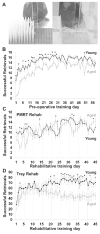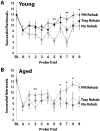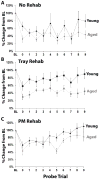Age-dependent reorganization of peri-infarct "premotor" cortex with task-specific rehabilitative training in mice
- PMID: 25009222
- PMCID: PMC4277492
- DOI: 10.1177/1545968314541329
Age-dependent reorganization of peri-infarct "premotor" cortex with task-specific rehabilitative training in mice
Abstract
Background: The incidence of stroke in adulthood increases with advancing age, but there is little understanding of how poststroke treatment should be tailored by age.
Objective: The goal of this study was to determine if age and task specificity of rehabilitative training affect behavioral improvement and motor cortical organization after stroke.
Methods: Young and aged mice were trained to proficiency on the Pasta Matrix Reaching Task prior to lesion induction in primary motor cortex with endothelin-1. After a short recovery period, mice received 9 weeks of rehabilitative training on either the previously learned task (Pasta Matrix Reaching), a different reaching task (Tray Reaching), or no training. To determine the extent of relearning, mice were tested once weekly on the Pasta Matrix Reaching Task. Mice then underwent intracortical microstimulation mapping to resolve the remaining forelimb movement representations in perilesion motor cortex.
Results: Although aged mice had significantly larger lesions compared with young mice, Pasta Matrix Reaching served as effective rehabilitative training for both age-groups. Young animals also showed improvement after Tray Reaching. Behavioral improvement in young mice was associated with an expansion of the rostral forelimb area ("premotor" cortex), but we failed to see reorganization in the aged brain, despite similar behavioral improvements.
Conclusions: Our results indicate that reorganization of motor cortex may be limited by either aging or greater tissue damage, but the capacity to improve motor function via task-specific rehabilitative training continues to be well maintained in aged animals.
Keywords: aging; brain mapping; forelimb; motor skills disorders; stroke.
© The Author(s) 2014.
Figures





Similar articles
-
Rehabilitative Training Interacts with Ischemia-Instigated Spine Dynamics to Promote a Lasting Population of New Synapses in Peri-Infarct Motor Cortex.J Neurosci. 2019 Oct 23;39(43):8471-8483. doi: 10.1523/JNEUROSCI.1141-19.2019. Epub 2019 Sep 11. J Neurosci. 2019. PMID: 31511430 Free PMC article.
-
Neural network remodeling underlying motor map reorganization induced by rehabilitative training after ischemic stroke.Neuroscience. 2016 Dec 17;339:338-362. doi: 10.1016/j.neuroscience.2016.10.008. Epub 2016 Oct 8. Neuroscience. 2016. PMID: 27725217
-
The Role of Endogenous Neurogenesis in Functional Recovery and Motor Map Reorganization Induced by Rehabilitative Therapy after Stroke in Rats.J Stroke Cerebrovasc Dis. 2017 Feb;26(2):260-272. doi: 10.1016/j.jstrokecerebrovasdis.2016.09.016. Epub 2016 Oct 12. J Stroke Cerebrovasc Dis. 2017. PMID: 27743923
-
Motor system plasticity in stroke models: intrinsically use-dependent, unreliably useful.Stroke. 2013 Jun;44(6 Suppl 1):S104-6. doi: 10.1161/STROKEAHA.111.000037. Stroke. 2013. PMID: 23709698 Free PMC article. Review.
-
The problem of relating plasticity and skilled reaching after motor cortex stroke in the rat.Behav Brain Res. 2008 Sep 1;192(1):124-36. doi: 10.1016/j.bbr.2007.12.026. Epub 2008 Jan 6. Behav Brain Res. 2008. PMID: 18282620 Review.
Cited by
-
Rehabilitative Training Interacts with Ischemia-Instigated Spine Dynamics to Promote a Lasting Population of New Synapses in Peri-Infarct Motor Cortex.J Neurosci. 2019 Oct 23;39(43):8471-8483. doi: 10.1523/JNEUROSCI.1141-19.2019. Epub 2019 Sep 11. J Neurosci. 2019. PMID: 31511430 Free PMC article.
-
Learning and Stroke Recovery: Parallelism of Biological Substrates.Semin Neurol. 2021 Apr;41(2):147-156. doi: 10.1055/s-0041-1725136. Epub 2021 Mar 9. Semin Neurol. 2021. PMID: 33690874 Free PMC article. Review.
-
Brain stimulation: Neuromodulation as a potential treatment for motor recovery following traumatic brain injury.Brain Res. 2016 Jun 1;1640(Pt A):130-138. doi: 10.1016/j.brainres.2016.01.056. Epub 2016 Feb 8. Brain Res. 2016. PMID: 26855256 Free PMC article. Review.
-
PDE2A Inhibition Enhances Axonal Sprouting, Functional Connectivity, and Recovery after Stroke.J Neurosci. 2022 Nov 2;42(44):8225-8236. doi: 10.1523/JNEUROSCI.0730-22.2022. Epub 2022 Sep 26. J Neurosci. 2022. PMID: 36163142 Free PMC article.
-
Longitudinal neural and vascular recovery following ultraflexible neural electrode implantation in aged mice.Biomaterials. 2022 Dec;291:121905. doi: 10.1016/j.biomaterials.2022.121905. Epub 2022 Nov 14. Biomaterials. 2022. PMID: 36403326 Free PMC article.
References
-
- Alaverdashvili M, Whishaw IQ. Compensation aids skilled reaching in aging and in recovery from forelimb motor cortex stroke in the rat. Neuroscience. 2010 Apr 28;167(1):21–30. - PubMed
Publication types
MeSH terms
Substances
Grants and funding
LinkOut - more resources
Full Text Sources
Other Literature Sources
Medical

